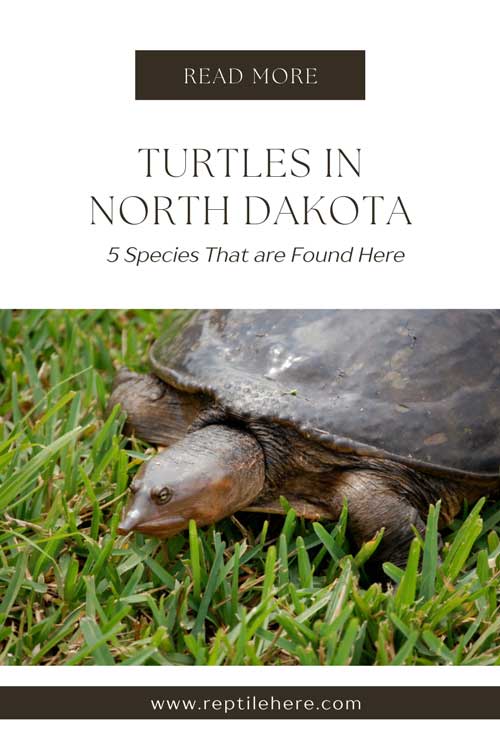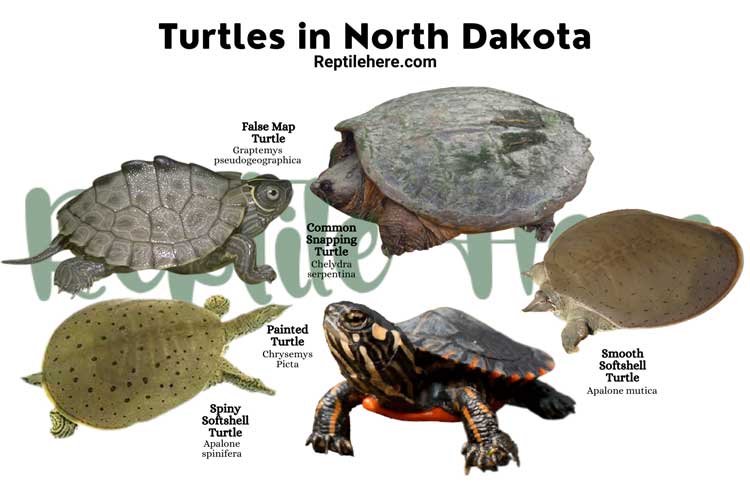Turtles in North Dakota – 5 Species That are Found Here
North Dakota is home to 4 turtle species only. These include the common snapping turtle, painted turtle, soft softshell turtle, spiny softshell turtle, and false map turtle.
The common snapping turtle, the ancient survivor, is the largest on the list—an average adult can achieve a shell up to 18.5 inches long! And the false map turtle is the smallest, with males achieving up to 6-inch maximum shell length.
Moreover, the common snapping turtle is the most common species in the state. The other species are a bit rare and not easily spotted in North Dakota.
Get the full details about each of these turtle species below and key facts defining them like habitat, size, diet, physical appearance, and more.
5 Types Of Turtles in North Dakota
Contents
1. Common Snapping Turtle
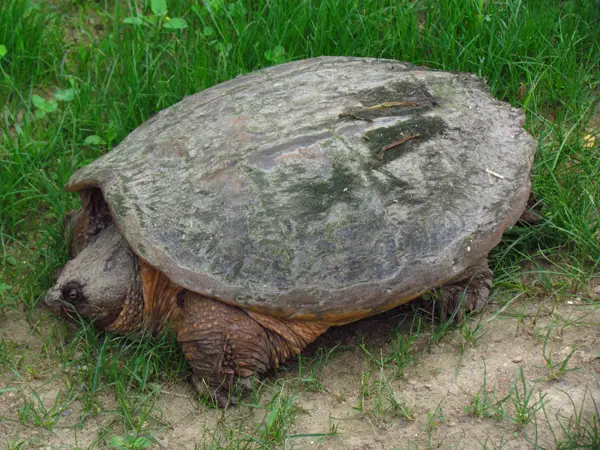
- Scientific name: Chelydra serpentina
- Common name: Snapping Turtle
- Family: Chelydridae
- Size: 8 to 18 1/2 inches
- Lifespan: 30 to 50 years or more
- Conservation status: Least Concern
The common snapping turtle is one of the most popular turtle species across the US states and is also found within the borders of North Dakota. These snapping turtles in North Dakota are unprotected and can be legally owned as pets.
An average common snapping adult turtle is pretty large and has a shell length of 18½ inches long. It is easily recognizable for this large size plus an intimidating appearance!
This species has a chunky head, a long tail, strong claws, and large webbed feet. The shell color is black or olive and has no distinct pattern. These North Dakota snapping turtles are also known for their hook-like powerful jaws—they’re so strong that these turtles eat other turtles!
You’ll find them in waterbodies with muddy bottoms. Examples include marshes, ponds, lakes, rivers, and even shallow streams. They generally prefer waters with aquatic vegetation in plenty and foods such as fish, frogs, birds, etc.
These North Dakota turtles generally show docile behavior but can get quite aggressive if taken out of water. The best way to calm it is to take it back to the waters, where it feels safe.
2. Painted Turtle
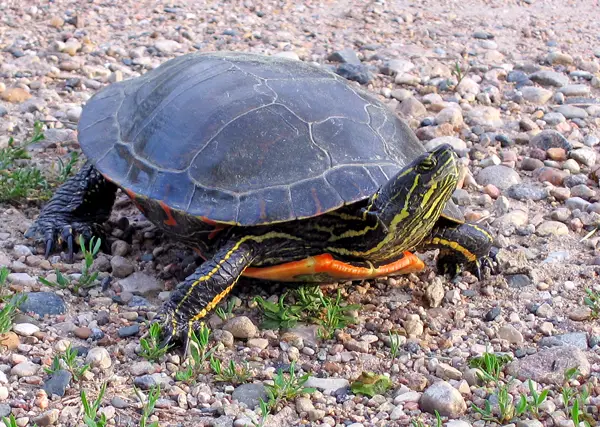
- Scientific name: Chrysemys picta
- Common name: Painted Turtle
- Family: Emydidae
- Size: 4 to 6 inches
- Lifespan: 30 to 50 years
- Conservation status: Least Concern
The Eastern painted turtle is one of the most recognizable turtle species in North Dakota, thanks to its beautiful and unique coloring. The bright reds and yellow-green markings on its shell, head, and limbs are no doubt a beauty to behold!
This painted turtle species in North Dakota has been observed to live near water bodies with minimal movements. Examples include marshes, ponds, slow-moving streams with sandy/muddy bottoms, small lakes, etc.
They also prefer areas with aquatic plants in plenty as they make their primary food source in the wild.
One interesting fact about these North Dakota turtles is their ability to hold their breath for up to 30 hours when inside temperate water. Moreover, they’re capable of standing dominant in freezing cold waters for up to 4 months.
Unfortunately, it’s not easy to establish the population of these turtles in North Dakota. This is because most people who pet them end up releasing them back into the wild. This contributes to an ever-expanding range plus unstable reproduction rates for these turtles.
3. Spiny Softshell Turtle
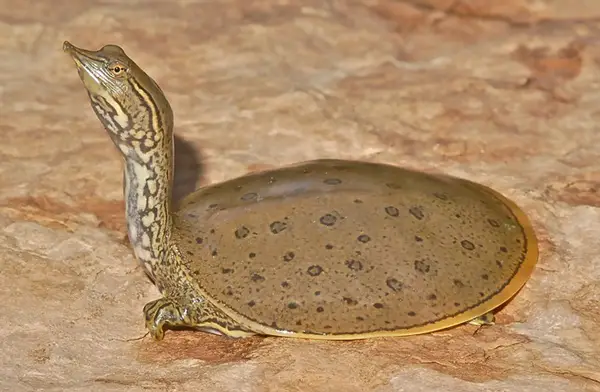
- Scientific name: Apalone spinifera
- Common name: Spiny Softshell Turtle
- Family: Trionychidae
- Size: 5 to 9 inches (males), 12 to 20 inches (females)
- Lifespan: 30 to 70 years
- Conservation status: Least Concern
The Spiny softshell turtle is a medium-to-large freshwater species that live in North Dakota’s lakes, streams, and rivers with muddy or sandy bottoms and little or no vegetation.
Female spiny softshell turtles are usually larger than males. And unlike other turtles, this species has a flexible, leather-like carapace that’s extremely rounded and flattened. The shell color can be olive grey or yellow-brown.
Just like other softshell turtles, this species also has a snorkel-like snout.
The young ones feature well-defined round spots that are easily visible on the shell (though these spots become invisible as they transition to adulthood).
Spiny softshell turtles in North Dakota tend to eat anything they find in the waters including crayfish, insects, small fish, and so on. They hunt by burying themselves in the mud or sand while keeping their head uncovered to grab food as it swims by.
These turtles are also able to breathe underwater by taking in oxygen through their throat skin. This is a useful adaptation given that they don’t spend a lot of time out of water.
Other adaptations of these turtles include webbed feed, long claws, and extremely flat shells that enable them to quickly swim away from predators and burry in the muddy bottom of the waters they reside in.
Also read: Turtles in Rhode Island
4. Smooth Softshell Turtle
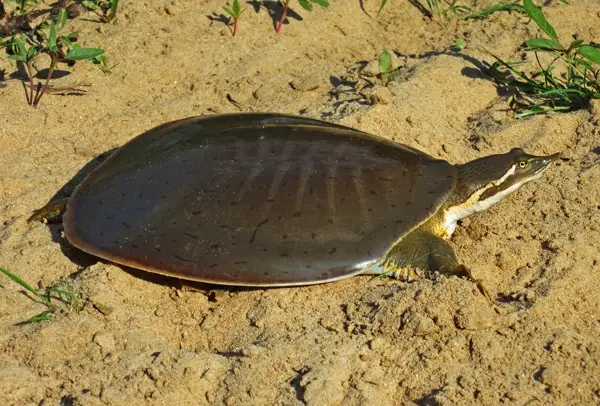
- Scientific name: Apalone mutica
- Common name: Midland Smooth Shell
- Family: Trionychidae
- Size: 6 to 13 inches
- Lifespan: 40 to 60 years
- Conservation status: Least Concern
The smooth softshell turtle boasts its position as the fastest turtle on land in North Dakota! Though most people believe these turtles are slow-moving, they must be quick to enable them to outrun their predators given that their soft shells don’t offer much protection.
Shell color of this turtle species ranges from olive to dark brown. The upper part of its shell features dark markings (with female markings appearing in a blotchier pattern than the males’)
The shell of these turtles also appears rounder and flatter, just like other softshell species.
These turtles like inhabiting waterbodies like rivers and streams in North Dakota that provide an abundance of mud or sand at the bottom. They can also be found in stagnant waterbodies.
Smooth softshell turtles of North Dakota are omnivorous and their diet revolves around aquatic vegetation and insects. However, they have been observed to like meat more than plant matter and will mainly eat snails, insects, and fish.
5. False Map Turtle
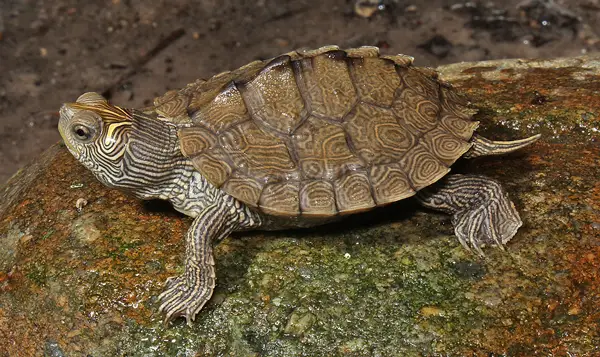
- Scientific name: Graptemys pseudogeographica
- Common name: False Map Turtle, Sawback Turtle
- Family: Emydidae
- Size: 6 to 10 inches (females), 3.5 to 6 inches (males)
- Lifespan: 30 to 50 years
- Conservation status: Least Concern
The False map turtle is another turtle species found in North Dakota. This turtle’s preferred habitat in North Dakota includes rivers, streams, and oxbow lakes of the Missouri and Mississippi river systems.
It is an excellent swimmer and prefers moderate currents and deep waters.
Its upper shell coloring ranges from olive to dark brown, with light-colored lines on its limbs. It also features a line behind its eye that forms a backward “L” shape. The map pattern on its carapace tends to fade as the turtle ages.
Since this map turtle of North Dakota is omnivorous, it feeds on aquatic insects and animals as well as vegetation. It is fond of river snails and crustaceans. Don’t forget it has strong jaws and can give a nasty bite!
Like most of the other aquatic turtles of North Dakota, this map turtle spends most of its waking hours sunning.
The false map turtle is quite shy and quietly and swiftly slides into the water at the slightest signs of disturbance. It likes spending most of its time in water and is most active in climate conditions of over 85 degrees Fahrenheit.
Related: Turtles in Wisconsin
Conclusion
Now you know what turtles live in North Dakota. While the state may not have such a diverse list when it comes to turtle species, it still boasts 4 turtle species living within its borders.
These include the common snapping turtle, smooth softshell, spiny softshell, and false map turtle. All these turtles are native to the state. The false map turtle is the smallest and the snapping turtle is the largest of all.
Note that the common snapping turtle is the most commonly spotted species in the state. The other 3 species are less common and their sightings are rare in North Dakota.
